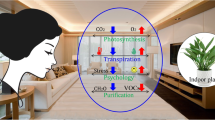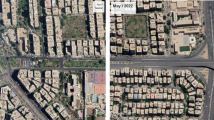Abstract
The arrangement of land use substantially affects outdoor human comfort. The purposes of this study were to develop a spatial optimization procedure that involves combining simulated annealing algorithm with a microclimate model (ENVI-met) and to identify the relationship between the spatial pattern of the major cooling source and human comfort. The procedure is an assessment tool for appropriately designing living space on a community scale. The physiological equivalent temperature (PET) was used as the index of human comfort, and the objective of optimization was to minimize the difference in the PET to 23 °C within the study area. Four types of land use, namely buildings, paddies, parks, and ponds, were considered. Given the types of land use and the land areas, the procedure is used to determine the optimal layout that provides the most comfortable environment. The results revealed that the optimal design effectively improved the homogeneity of human comfort quantitatively and spatially in summer. Human comfort in the entire area was improved when the prevailing wind first passes through cooling sources, such as the paddies, and the walkways are easier to cool when the cooling sources are located nearby. The results of the spatial optimization procedure can further be applied to determine the relationship between the spatial pattern of land use and human comfort, and the relationship can be used as a reference for future research on community design.









Similar content being viewed by others
References
Ali-Toudert F, Mayer H (2006) Numerical study on the effects of aspect ratio and orientation of an urban street canyon on outdoor thermal comfort in hot and dry climate. Build Environ 41:94–108
Arnfield A (1990) Street design and urban canyon solar access. Energy Build 14:117–131
Asawa T, Hoyano A, Nakaohkubo K (2008) Thermal design tool for outdoor spaces based on heat balance simulation using a 3D-CAD system. Build Environ 43:2112–2123
Bruse M (2004) ENVI-met 3.0: updated model overview, University of Bochum Available at www.envi-met.com
Chen H, Ooka R, Kato S (2008) Study on optimum design method for pleasant outdoor thermal environment using genetic algorithms (GA) and coupled simulation of convection, radiation and conduction. Build Environ 43:18–30
Corana A, Marchesi M, Martini C, Ridella S (1987) Minimizing multimodal functions of continuous variables with the “simulated annealing” algorithm Corrigenda for this article is available here. ACM Trans Math Softw (TOMS) 13:262–280
Fintikakis N et al (2011) Bioclimatic design of open public spaces in the historic centre of Tirana, Albania. Sustain Cities Soc 1:54–62
Fröhlich D, Matzarakis A (2013) Modeling of changes in thermal bioclimate: examples based on urban spaces in Freiburg, Germany. Theor Appl Climatol 111:547–558
Grimmond S (2007) Urbanization and global environmental change: local effects of urban warming. Geogr J 173:83–88
He J, Hoyano A, Asawa T (2009) A numerical simulation tool for predicting the impact of outdoor thermal environment on building energy performance. Appl Energy 86:1596–1605
Herrmann J, Matzarakis A (2010) Influence of mean radiant temperature on thermal comfort of humans in idealized urban environments Berichte des Meteorologischen Instituts der Albert-Ludwigs-Universität Freiburg, p 522
Honjo T, Takakura T (1991) Simulation of thermal effects of urban green areas on their surrounding areas. Energy Build 15:443–446
Höppe P (1999) The physiological equivalent temperature—a universal index for the biometeorological assessment of the thermal environment. Int J Biometeorol 43:71–75
Hsieh C-M, Chen H, Ooka R, Yoon J, Kato S, Miisho K (2010) Simulation analysis of site design and layout planning to mitigate thermal environment of riverside residential development. In: Building simulation vol. 1, Springer, pp 51–61
Huang L, Li J, Zhao D, Zhu J (2008a) A fieldwork study on the diurnal changes of urban microclimate in four types of ground cover and urban heat island of Nanjing, China. Build Environ 43:7–17
Huang Y, Musy M, Hégron G, Chen H, Li B (2008b) 663: Towards urban design guidelines from urban morphology description and climate adaptability
Kirkpatrick S (1984) Optimization by simulated annealing: quantitative studies. J Stat Phys 34:975–986
Kirkpatrick S, Vecchi M (1983) Optimization by simmulated annealing. Science 220:671–680
Laarhoven Pv (1987) Theoretical and computational aspects of simulated annealing = Theoretische en computationele aspekten van gesimuleerde tempering. Geldrop: Van Laarhoven
Lin T-P, Matzarakis A, Hwang R-L (2010a) Shading effect on long-term outdoor thermal comfort. Build Environ 45:213–221
Lin T-P, Matzarakis A, Hwang R-L, Huang Y-C (2010b) Effect of pavements albedo on long-term outdoor thermal comfort Berichte des Meteorologischen Instituts der Albert-Ludwigs-Universität Freiburg, p 497
Martinez-Rios F, Frausto-Solis J (2012) A simulated annealing algorithm for the satisfiability problem using dynamic markov chains with linear regression equilibrium
Matzarakis A, Mayer H, Iziomon MG (1999) Applications of a universal thermal index: physiological equivalent temperature. Int J Biometeorol 43:76–84
Mayer H (1993) Urban bioclimatology. Experientia 49:957–963
Mayer H, Höppe P (1987) Thermal comfort of man in different urban environments. Theor Appl Climatol 38:43–49
Mayer H, Holst J, Dostal P, Imbery F, Schindler D (2008) Human thermal comfort in summer within an urban street canyon in Central Europe. Meteorol Z 17:241–250
McGarigal K, Marks BJ (1995) Spatial pattern analysis program for quantifying landscape structure Gen Tech Rep PNW-GTR-351 US Department of Agriculture, Forest Service, Pacific Northwest Research Station
Murakami S (2006) Environmental design of outdoor climate based on CFD. Fluid Dyn Res 38:108–126
Nastos PT, Matzarakis A (2012) The effect of air temperature and human thermal indices on mortality in Athens, Greece. Theor Appl Climatol 108:591–599
Ng E (2009) Policies and technical guidelines for urban planning of high-density cities—air ventilation assessment (AVA) of Hong Kong. Build Environ 44:1478–1488
Nunez M, Oke TR (1977) Energy balance of an urban canyon. J Appl Meteorol 16:11–19
Potchter O, Cohen P, Bitan A (2006) Climatic behavior of various urban parks during hot and humid summer in the Mediterranean city of Tel Aviv, Israel. Int J Climatol 26:1695–1711
Robitu M, Musy M, Inard C, Groleau D (2006) Modeling the influence of vegetation and water pond on urban microclimate. Sol Energy 80:435–447
Rose J, Klebsch W, Wolf J (1990) Temperature measurement and equilibrium dynamics of simulated annealing placements. Comput Aided Des Integr Circuits Syst IEEE Trans 9:253–259
Shashua-Bar L, Potchter O, Bitan A, Boltansky D, Yaakov Y (2010) Microclimate modelling of street tree species effects within the varied urban morphology in the Mediterranean city of Tel Aviv, Israel. Int J Climatol 30:44–57
Sorkin GB (1991) Efficient simulated annealing on fractal energy landscapes. Algorithmica 6:367–418
Spearman C (1904) The proof and measurement of association between two things. Am J Psychol 15:72–101
Srichander R (1995) Efficient schedules for simulated annealing. Eng Optim 24:161–176
Stavrakakis G, Tzanaki E, Genetzaki V, Anagnostakis G, Galetakis G, Grigorakis E (2012) A computational methodology for effective bioclimatic-design applications in the urban environment. Sustain Cities Soc 4:41–57
Taylor R (1990) Interpretation of the correlation coefficient: a basic review. J Diagn Med Sonogr 6:35–39
Upmanis H, Eliasson I, Lindqvist S (1998) The influence of green areas on nocturnal temperatures in a high latitude city (Göteborg, Sweden). Int J Climatol 18:681–700
VanDerWal J, Falconi L, Januchowski S, Shoo L, Storlie C (2011) SDMTools: species distribution modelling tools: Tools for processing data associated with species distribution modelling exercises R package version 1
Wong N, Kardinal Jusuf S, Aung La Win A, Kyaw Thu H, Syatia Negara T, Xuchao W (2007) Environmental study of the impact of greenery in an institutional campus in the tropics. Build Environ 42:2949–2970
Yoshida S, Murakami S, Ooka R, Mochida A, Tominaga Y (2000) CFD prediction of thermal comfort in microscale wind climate. Comput Wind Eng, pp 27–30
Acknowledgments
The authors gratefully acknowledge the National Science Council of Taiwan for funding this study under Contract No. MOST 102-2628-B-002-020. An Optimization Model for Land Use Arrangement in a Community—Based on Human Comfort Perspective
Author information
Authors and Affiliations
Corresponding author
Rights and permissions
About this article
Cite this article
Chen, PY., Tung, CP., Lin, WC. et al. Spatial optimization procedure for land-use arrangement in a community based on a human comfort perspective. Paddy Water Environ 14, 71–83 (2016). https://doi.org/10.1007/s10333-015-0479-x
Received:
Revised:
Accepted:
Published:
Issue Date:
DOI: https://doi.org/10.1007/s10333-015-0479-x




